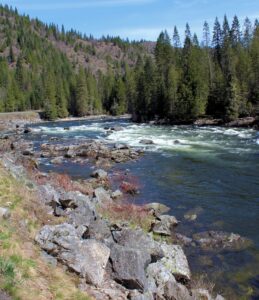
This month we travel to the Pacific Northwest state of Idaho. Nicknamed, the gem state, Idaho is the 14th largest of the 50 states. It is known for it’s mountainous landscapes, vast areas of protected wilderness and outdoor recreation areas.
Forming part of the Pacific Northwest (and with the associated Cascadia Bioregion), Idaho is divided into several distinct geographic and climatic regions. The state’s north, relatively isolated Idaho Panhandle, is closely linked with Eastern Washington with which it shares the Pacific Time Zone- the rest of the state uses the Mountain Time Zone. The state’s south side includes the Snake River Plain which includes most of the population and agricultural land. The state is quite mountainous, containing part of the Rocky Mountains.
Business Climate
Idaho is an important agricultural state, producing nearly one-third of the potatoes in the United States. Additionally, all three varieties of wheat, dark northern spring, hard red, and soft white are grown in the state.
Idaho’s industrial economy is growing, with high-tech products leading the way. Since the late 1970s, Boise has emerged as a center for semiconductor manufacturing. It is the home of Micron Technology, the only U.S. manufacturer of dynamic random-access memory (DRAM) chips. Hewlett-Packard has operated a large plant in Boise since the 1970s, which is devoted primarily to Laserjet printers production.
A number of fortune 500 companies started in or trace their roots to Idaho, including Safeway in American Falls, Albertsons in Boise, JR Simplot across southern Idaho, and Potlatch Corp. in Lewiston. Zimmerly Air Transport in Lewiston-Clarkston was one of the five companies in the merger centered around Varney Air Lines of Pasco, WA, which became United Airlines and subsequently Varney Air Group which became Continental Airlines.
Tax Climate
The top individual income tax rate is 5.8% and the top corporate income tax rate is also 6%.
Apportionment: Idaho uses a double weighted sales formula (meaning that it uses 3 factors with its sales factor double weighted) for the apportionment of corporate income taxes.
Idaho uses the cost of performance method for the sourcing of services and intangible property. Receipts from services and intangibles are based on where the service was performed.
Sales Tax Structure
The state sales tax rate is 6%. Food is taxed, but prescription drugs are not. Hotel, motel, and campground accommodations are taxed at a higher rate (7% to 11%).
Idaho has enacted economic nexus legislation. Effective June 1, 2019, retailers who in the previous or current calendar year that have accumulative gross receipts from sales delivered into the state in excess of $100,000 are considered to be engaged in business and must collect sales and use tax. Cumulative gross receipts from sales including taxable products and taxable services delivered into the state, exempt sales and exempt services are included in the threshold. There are not any transactions that are excluded from the threshold.
Marketplace facilitators with a physical presence in Idaho and remote marketplace facilitators with more than $100,000 in combined sales into the state must collect and remit state tax on all sales into the state, their own and those by third party sellers. Remote marketplaces are not responsible for collecting local sales tax. This legislation went into effect on June 1, 2019.
Idaho is moderate in its approach to the taxation of technology products for sales tax purposes. Idaho includes in the definition of tangible personal property, digital music, digital books, digital videos and digital games. Tax is imposed on transactions involving software when the purchaser has a permanent right to use the software regardless of the method of delivery or access. Prewritten computer software that is electronically downloaded is nontaxable and custom computer software that is electronically downloaded is also exempt. Lastly, all cloud computing is nontaxable. How products are produced, sold and delivered is critical to determining their tax status.
Many states have annual sales tax holidays, during which certain items the state wants to promote the purchase of (like school supplies, emergency preparedness supplies, or energy efficient appliances) can be purchased sales tax free. However, Idaho does not currently have any scheduled sales tax holidays.
Random Facts
- Idaho is sometimes referred to as the Gem State, for its abundance of natural resources. One can find nearly 72 types of precious stones in the state. Some of them include jasper, opal, jade, topaz, zircon and tourmaline.
- Idaho is home to the Niagara of the West. Those who want to experience something like Niagara Falls could check out Shoshone Falls with its 65 meter (212 feet) drop, which is 14 meters (45 feet) higher than Niagara Falls.
- Idaho may be known for its potatoes, but it should be known for its trout too. It is estimated that 85% of all of the commercial trout sold in the United States comes from the Hagerman Valley in Idaho.
- Boise, Idaho is home to the Treefort Music Fest, which is one of the most successful modern country music festivals in America.
- The waters of the Snake River rush through Hells Canyon, the deepest gorge in the United States at 2,436 meters (7,993 feet).
- Lake Coeur d’Alene a is natural lake in northern Idaho. Its northern end is in the city of Coeur d’Alene. It spans 40 kilometers (25 miles) in length and ranges from 1.5 to 5 kilometers (1 to 3 miles) wide with over 175 kilometers (109 miles) of shoreline. The lake was named after the Coeur d’Alene people.
- Thousands of miners rushed into Idaho when word of a major gold strike came in September 1860.
- The state seal of Idaho is the only state seal in the United States designed by a woman in 1891 by Emma Edwards Green.
Our team at Miles Consulting Group is available to discuss the specifics of your state tax situation, whether in Idaho or other states, we can help you navigate the complex tax structures arising from your multistate operations. Call us to help you achieve the best tax efficiencies.


















